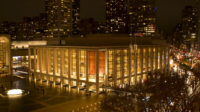The mystery about the architect for 2 World Trade Center is now solved. Today, architecture firm Bjarke Ingels Group (BIG) showed off its new design for 2 World Trade Center—a gleaming, 1,340-foot-tall stack of seven glazed volumes—that will replace an earlier scheme by Foster + Partners.
“The building has to be a respectful and dignified finalization of the towers and memorial, but also a lively, engaging, living building,” Ingels told RECORD in an interview.
An April 24 article in the Wall Street Journal created a brouhaha when it announced that the Danish architect would replace Norman Foster’s design in order to accommodate 21st Century Fox and News Corp’s new downtown headquarters. After more than a month of silence (internally the project was referred to as “Project Gotham”), the two companies announced that they had reached a non-binding agreement with Silverstein Properties, the site’s developer.
The BIG-designed tower will further the vibrant transformation of the Financial District, joining Trade Centers One, 3, and 4 by SOM, Rogers Stirk Harbour + Partners, and Fumihiko Maki, respectively, as well as Santiago Calatrava’s seagull-like transportation hub and the 9/11 memorial and museum, designed by Davis Brody Bond and Michael Arad, among others.
Standing shoulder-to-shoulder with SOM’s One World Trade Center (completed last year) at the border between the Financial District and Tribeca, Ingels says the building will have two different addresses: “From the harbor it will be 2 World Trade and from the other side, it will be 200 Greenwich Street. Because of its location and its size it somehow has to be a local resident of two radically different neighborhoods.”
From Tribeca, the tower will appear as a series of stacked terraces, while the southern end will appear like a slim tower akin to its Financial District counterparts.
The original 79-story Foster tower, designed in 2006, consisted of four interconnected vertical elements that came to a diamond-shaped apex. Unlike the original scheme, which anticipated a population of investment bankers when it was designed nearly a decade ago, the BIG design is conceived for a media company and incorporates office design du jour, with nearly one acre of outdoor terraces with lush plantings, open-planned offices, and will accommodate basketball courts, an indoor running track, cafeterias, and screening rooms.
21st Century Fox and News Corp with their some 5,000 employees will occupy the lower half of the tower, complete with open TV studios and newsrooms, while the upper portion will be reserved for future tenants. The base of the tower will have 350,000 square feet devoted to shops and restaurants, as well as a public plaza and access points to the 11 transit lines at the site.
The new tower also looks to the past. The design is careful to maintain views to St. Paul’s chapel and the 9/11 memorial site, and will appear to lean toward One World Trade Center, complementing its geometry “not like the twinning of the Twin Towers, but more like kind of yin/yang acknowledgement,” Ingels says.
For Ingels, the project is personal: in September 2001 the architect was in the process of moving into his first office in Manhattan, paint still fresh on the walls, when the first plane hit the Twin Towers, and then the second. “I think everybody thought of the skyline of New York as something that was irreversible,” he said. “It’s a tremendous honor, something we are taking incredibly seriously, and I will be proud of.”
Architect Daniel Libeskind, who designed the World Trade Center master plan, said in a statement, “I couldn’t be more thrilled to see the master plan come closer to completion.”
Although a story in Wired reported that, “James Murdoch didn’t care for the building...that’s why Foster ended up being bumped aside in favor of Ingels, who is exactly half his age,” 21st Century Fox and News Corp brought Ingels on before a site was even chosen.
With a lease on 1211 Avenue of the Americas in Midtown set to expire in 2020, 21st Century Fox COO James Murdoch and CFO John Nallen had been assessing company needs. Early this year, after evaluating a wide arrange of architects, they ultimately chose BIG. But World Trade Center wasn’t the only site considered: Hudson Yards and other locations were also potential candidates. The BIG scheme isn’t necessarily the final one either: “While no final decisions have been made, we look forward to continuing to work with SPI on the design of the new headquarters and terms of our lease arrangement,” according to the companies’ joint statement.
BIG has been receiving increasingly prominent commissions in recent years—including Google’s new headquarters in California, plus several other projects in Manhattan, including the pyramid-shaped luxury tower W57. BIG is also working with Foster + Partners on the design for the Battersea Park in London. “I have only respect for Lord Norman Foster and his team,” Ingels says.
“Foster + Partners designed a beautiful building, but unfortunately it doesn’t match the specific needs of our new tenants,” Silverstein Properties spokesperson Dara McQuillan said in a statement. He added, “We are working with the firm on two office buildings in China and look forward to working with them on many new and exciting projects.”
Foster + Partners could not be reached by press time for comment.
While a lot of the heavy lifting has already been done at the site (a foundation was laid years ago in anticipation of the Foster + Partners’ tower), the team has set forth an ambitious goal to have the project finished by late 2020. Says Ingels, “We have our work cut out for us.”




































Post a comment to this article
Report Abusive Comment